For ideal hot pepper fermentation, you'll want to use a salt ratio between 3.5% to 4% of your total pepper weight. Using non-iodized salt, weigh your peppers first, then multiply that weight by 0.035 to calculate the exact amount of salt needed. This creates the perfect environment for beneficial bacteria while blocking harmful microorganisms. You'll need to keep all peppers fully submerged in the brine and maintain temperatures between 60-75°F for best results. A digital scale guarantees accuracy, but don't worry if you're not sure about the calculations – there's a simple way to master the process.
Why Salt Matters in Fermentation
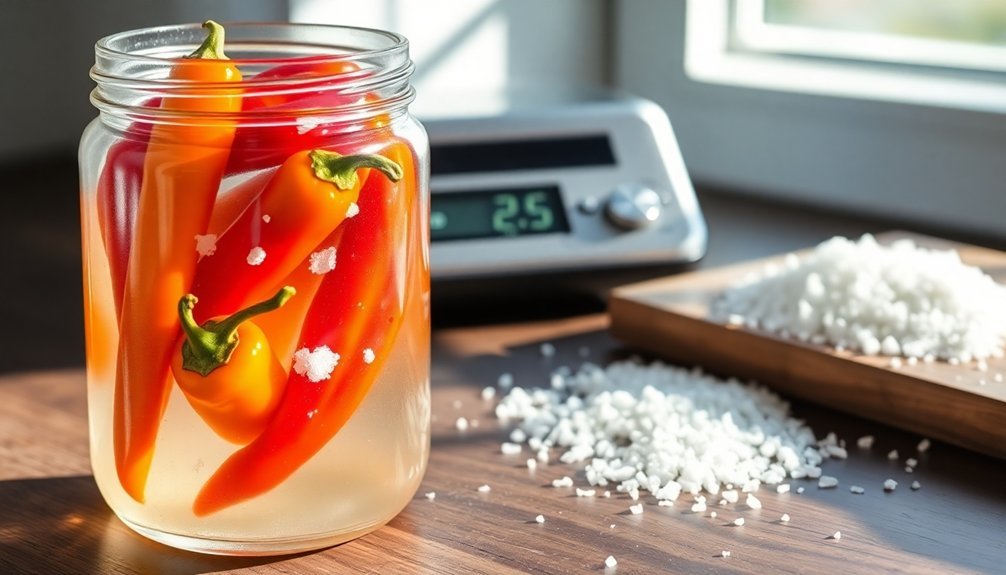
Throughout the fermentation process, salt plays a vital role far beyond mere seasoning. When you're fermenting hot peppers, salt creates the perfect environment for beneficial bacteria to thrive while preventing harmful microorganisms from taking hold. It works by drawing water out of microbial cells, effectively controlling which bacteria can survive in your ferment. Maintaining a consistent temperature range between 65°F and 75°F will ensure optimal fermentation conditions.
You'll find that salt's ability to reduce water activity is essential for successful fermentation. It creates an ideal brine environment where beneficial bacteria can flourish while keeping unwanted microbes at bay. This careful balance guarantees your hot peppers ferment properly and develop their characteristic tangy flavor.
The salt concentration you use will directly impact how quickly and effectively your peppers ferment. A range of 2-5% salt by weight typically works best for vegetable fermentations. If you don't use enough salt, your ferment might spoil before the beneficial bacteria can establish themselves.
Conversely, too much salt can slow down or halt the fermentation process entirely. Getting this balance right guarantees proper lactic acid production, which not only preserves your peppers but also contributes to their complex, probiotic-rich final product.
Choosing the Right Salt Type
Selecting the right salt is essential for successful hot pepper fermentation. You'll want to use minimally processed sea salt as your top choice, as it provides the cleanest flavor and fewest impurities. A 3% brine solution is standard for safely fermenting hot peppers. If you can't find sea salt, pickling salt serves as an excellent alternative since it's pure and additive-free.
When choosing your salt, make sure it's non-iodized. Iodized table salt can interfere with the fermentation process and should be avoided completely. You'll also want to steer clear of salts containing anti-caking agents or other additives that could compromise your ferment.
While you can use mined salts like Himalayan or Redmond Real Salt, be aware that they may leave sediment in your ferment. If you're aiming for a clear final product, you might want to stick with sea salt or pickling salt instead.
The consistency of your results depends largely on using the same type of salt in your ferments. By choosing a high-quality, additive-free salt and sticking with it, you'll develop a better understanding of how your ferments behave and achieve more predictable outcomes in your hot pepper fermentations.
Basic Salt Percentage Guidelines
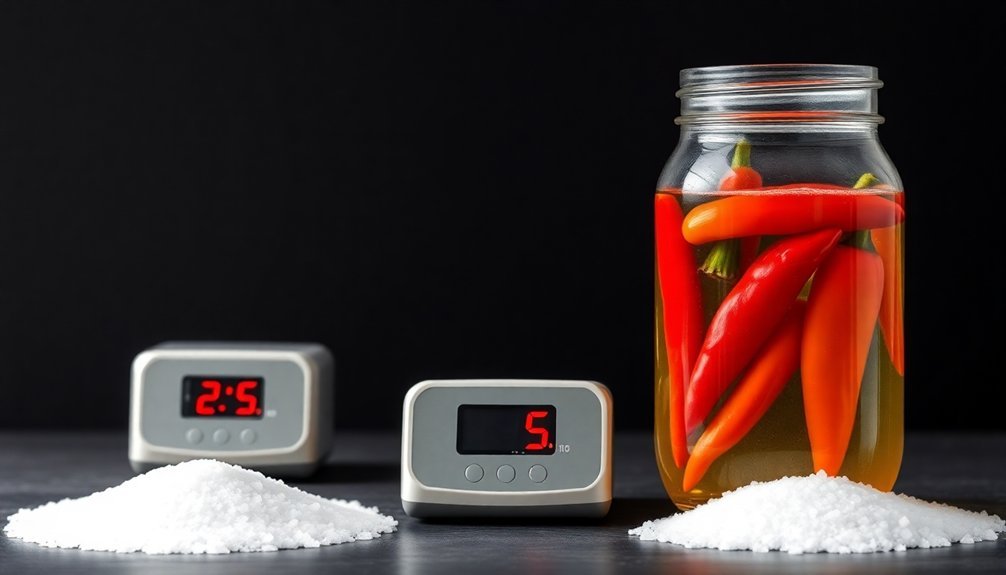
Salt percentages form the backbone of successful hot pepper fermentation. For hot peppers, you'll want to aim for a 3.5% to 4% salt concentration, though you can safely work within a broader 2% to 5% range. This sweet spot guarantees proper fermentation while maintaining both flavor and preservation. Beneficial bacteria thrive in this salt concentration range while harmful microorganisms are kept at bay.
| Salt % | Benefits | Best For |
|---|---|---|
| 2-3% | Faster fermentation | Mild peppers, mixed vegetables |
| 3.5-4% | Ideal balance | Most hot peppers, jalapenos |
| 4-5% | Extra crunch, longer shelf life | Very hot peppers, thick-walled varieties |
You'll need to calculate your salt ratio based on the total weight of peppers and water combined. If you're working with particularly spicy varieties like jalapenos or serranos, you can push the ratio up to 6% without compromising the fermentation process. Keep in mind that higher salt concentrations will slow down fermentation but help maintain crunchiness. Lower concentrations speed up the process but may increase spoilage risks. While precise measurements aren't absolutely essential for home fermentation, staying within these guidelines will consistently produce safe, flavorful results.
Calculating Your Brine Solution
Precision matters when calculating your brine solution for fermenting hot peppers. For hot peppers, you'll want to aim for a 3-5% brine concentration, which you can calculate using either weight or volume methods.
To calculate by weight, first weigh your water in grams. For example, if you're using 1 cup (236 grams) of water and want a 3.5% brine, multiply 236 by 0.035 to determine you need 8.26 grams of salt. Use a kitchen scale for accuracy, as even small variations can affect your fermentation.
For volume calculations, measure your jar's capacity in milliliters. If you're using a 1-liter jar, a 3.5% brine requires 35 grams of salt. For a 750ml jar, you'll need 26.25 grams. Remember that your jar should be filled completely to maintain accurate ratios.
You can simplify these calculations using a brine calculator or by keeping notes from previous successful fermentations. If you're working with particularly spicy peppers, consider starting at 3% and adjusting future batches based on your results.
Don't forget to account for any additional ingredients that might affect the fermentation process.
Salt Impact on Beneficial Bacteria
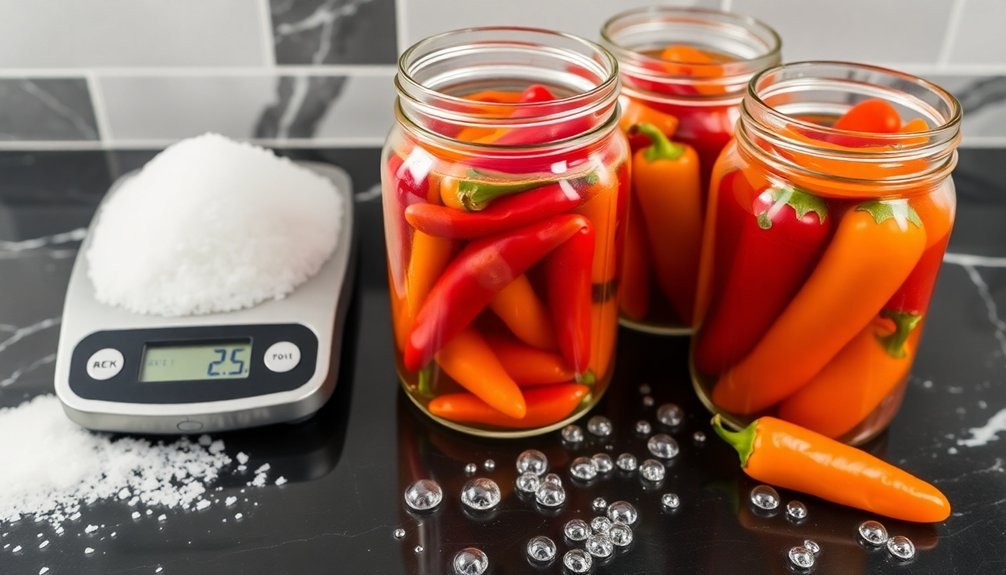
When you're fermenting hot peppers, you'll want to guarantee your salt ratio promotes beneficial bacteria like Lactobacillus while keeping harmful microbes at bay.
Your salt concentration should stay between 2-4% of total ingredients by weight, as this range supports good bacterial growth while maintaining proper preservation.
Getting these measurements right is essential, so you'll need to accurately weigh both your peppers and salt to achieve the ideal environment for fermentation.
Salt Promotes Good Bacteria
The delicate balance of beneficial bacteria in fermented hot peppers relies heavily on proper salt concentration. When you add the right amount of salt to your pepper ferment, you're creating an ideal environment for beneficial bacteria like Lactobacillus and Leuconostoc to thrive while preventing harmful bacteria from growing.
Salt works by drawing moisture from the peppers to create a brine solution. This brine becomes the perfect habitat for lactic acid bacteria (LAB), which are essential for successful fermentation. As these beneficial bacteria multiply, they produce lactic acid that further protects your ferment by lowering the pH to levels where pathogens can't survive.
You'll want to maintain a salt concentration between 2-5% by weight for your hot pepper ferments. This range is vital because it's where beneficial bacteria operate most efficiently. If you use too little salt, you'll risk contamination from unwanted microorganisms.
Conversely, if you exceed 6% salt concentration, you'll slow down the beneficial bacteria's activity considerably. The salt also manages osmotic pressure, drawing out water from the peppers while maintaining their texture and ensuring the development of those complex, fermented flavors you're looking for.
Balancing Growth And Safety
Finding the sweet spot for salt concentration requires careful attention to microbial dynamics. You'll want to maintain a delicate balance between promoting beneficial bacteria and inhibiting harmful ones. For hot pepper fermentation, aim for a 2-3% salt concentration to create ideal conditions for lactobacillus growth while guaranteeing food safety.
- Too little salt can allow unwanted bacteria to thrive, risking spoilage.
- Too much salt will slow down or stop beneficial bacterial activity.
- Proper salt levels create a protective brine environment.
- Salt concentrations above 6% greatly reduce lactobacillus activity.
- The right balance guarantees efficient lactic acid production.
When you're fermenting hot peppers, you'll notice that the correct salt ratio helps draw moisture from the peppers, creating a natural brine solution. This process manages osmotic pressure and reduces water activity, which is essential for preservation.
While lactobacillus can survive in salt concentrations up to 8-10%, you'll get the best probiotic benefits by staying within the recommended range. Remember to avoid iodized salt with additives, as they can interfere with the fermentation process. Instead, opt for pure sea salt or rock salt to support healthy bacterial growth.
Measuring Salt Accurately
Accurate salt measurements play an essential role in creating the perfect environment for beneficial bacteria during hot pepper fermentation. You'll need to use precise weight measurements rather than volume measurements to guarantee consistent results. For a successful ferment, you should use a digital scale to weigh both your peppers and salt.
To calculate the correct amount of salt, multiply the total weight of your peppers and water by your desired salt percentage. For example, if you're fermenting 500 grams of hot peppers and using a 2.5% salt concentration, you'll need 12.5 grams of salt.
| Weight Component | Calculation Method | Result Example |
|---|---|---|
| Peppers + Water | Total Combined Weight | 500g |
| Salt Percentage | Desired Concentration | 2.5% |
| Salt Weight | Total Weight × Percentage | 12.5g |
| Final Brine | Peppers + Water + Salt | 512.5g |
The precision in your salt measurements directly affects the growth of beneficial bacteria like Lactobacillus. When you maintain accurate salt ratios, you're creating an environment that encourages proper fermentation while inhibiting harmful bacteria. This balance guarantees your hot peppers develop the right flavors and probiotic benefits during fermentation.
Testing Your Brine Concentration
You'll want to gather a few key tools to test your brine concentration accurately: a digital refractometer like SmartRef, a conductivity meter, or a digital scale for weight calculations.
For quick testing using the weight method, simply weigh your water and calculate 2-3% of that weight in salt to achieve the right concentration for fermenting hot peppers.
If you're running a commercial operation, consider investing in both a refractometer and conductivity meter to maintain consistent quality across batches.
Equipment Needed For Testing
Several reliable tools are available for testing your brine concentration when fermenting hot peppers.
Digital refractometers offer quick and accurate measurements using just a few drops of brine, displaying results in %w/w or g/L. You'll appreciate their compatibility with mobile apps for enhanced functionality, whether you're fermenting small or large batches.
- Salometers give you precise readings of salt concentration and brine freeze points.
- Digital refractometers need only a few drops for accurate measurements.
- Conductivity sensors work well for concentration-sensitive fermentation.
- Hydrometers offer reliable readings on a custom 0-26% scale.
- Specific gravity sensors measure brine density with high precision.
For the most accurate results, you'll want to take into account using a digital refractometer or salometer, as they're specifically designed for brine solutions.
If you're running a larger operation, conductivity sensors provide consistent monitoring of your fermentation. They use either contacting sensors with AC waveform technology or toroidal sensors with a two-coil system that requires less maintenance.
Whatever tool you choose, you'll need only a small sample of brine to get accurate readings, making the testing process quick and efficient.
Salt Percentage Quick Methods
While specialized testing equipment offers precision, simple calculation methods can quickly determine your brine concentration for fermenting hot peppers.
Your first step is to weigh all ingredients, including peppers and water, then multiply the total weight by your desired salt percentage. For hot peppers, you'll want to aim for 3.5-4% salt concentration to maintain crispness while ensuring proper fermentation.
Here's a straightforward method: If you have 800g of peppers and 200g of water, your total weight is 1,000g. For a 4% brine, multiply 1,000 by 0.04, giving you 40g of salt needed.
If you don't have a scale, you can use volume measurements – roughly 1 tablespoon of sea salt per 4 cups of water creates a 2% brine. For hot peppers, you'll want to increase this to about 1.5-2 tablespoons per 4 cups to reach the ideal 3.5-4% range.
Remember that higher salt concentrations will slow fermentation but help maintain pepper crunchiness.
Don't exceed 5% salt content, as this can inhibit the fermentation process entirely.
Common Salt Ratio Mistakes

During the fermentation process, getting your salt ratios right can make the difference between a successful hot pepper ferment and a failed batch.
Let's examine the most common mistakes that can derail your fermentation project and how to avoid them.
The most critical errors occur when measuring salt concentrations. You'll want to stay within the 2-4% range, with 3% being ideal for most pepper ferments. When calculating your salt ratio, remember to weigh both the peppers and water together, not just the water alone. Using a kitchen scale guarantees accuracy and helps you avoid the common mistake of including the container weight in your calculations.
- Using salt concentrations below 2% that won't protect against harmful bacteria
- Adding too much salt (above 6%) which inhibits beneficial lactobacillus
- Failing to weigh both peppers and water when calculating salt ratios
- Choosing salt with anti-caking agents or additives that can interfere with fermentation
- Not monitoring brine levels and allowing peppers to float above the surface
Once you've got your measurements right, maintain proper fermentation by keeping ingredients submerged, leaving headspace for expansion, and allowing gases to escape by loosely sealing your jar.
Adjusting Salt for Different Peppers
Getting your salt ratios dialed in for different pepper varieties doesn't have to be complicated. While you might be fermenting anything from mild jalapeños to scorching ghost peppers, you'll want to maintain a consistent salt concentration between 3% to 3.5% for ideal results. This sweet spot works effectively across all pepper varieties and helps prevent unwanted growth while promoting beneficial bacteria.
To calculate your salt ratio, simply weigh your peppers and water together, then multiply that total by 0.03 (for 3%). For example, if you've got 900 grams of peppers and water combined, you'll need 27 grams of salt. Dissolve this in warm water before adding it to guarantee even distribution throughout your ferment.
Remember that while different peppers may require varying preparation methods – like removing seeds for milder varieties or keeping them in for extra heat – your salt ratio shouldn't change.
What's most important is keeping your peppers fully submerged in the brine, regardless of variety. You can adjust fermentation time based on your desired flavor profile, but maintaining proper salt concentration remains essential for successful fermentation across all pepper types.
Long Term Storage Salt Levels
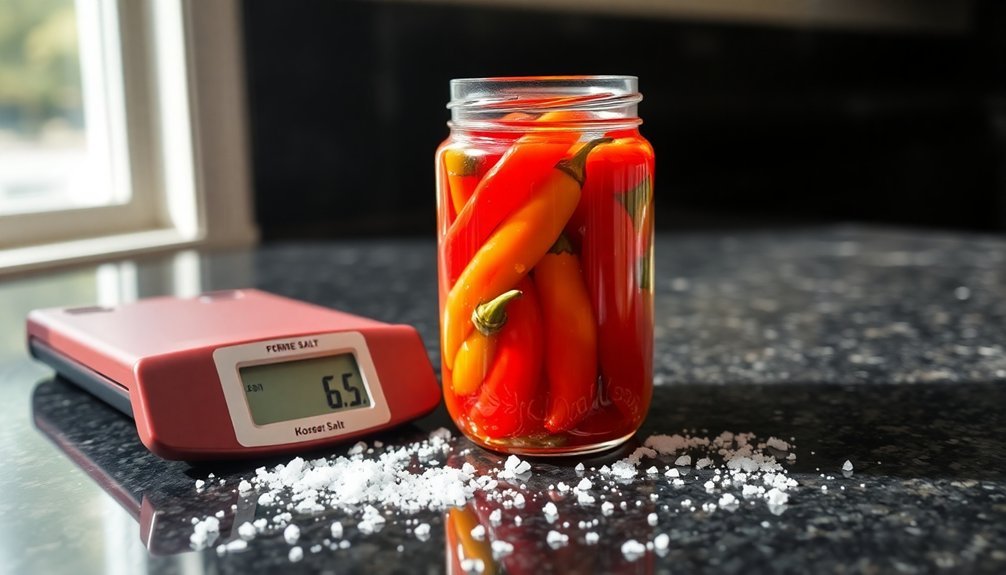
The salt levels in your fermented peppers need adjusting up to 4-5% for successful long-term storage. Higher salt concentrations help preserve your peppers by inhibiting unwanted bacteria and mold growth while maintaining the probiotic benefits you've worked hard to develop.
When you're planning to store your fermented peppers for several months, you'll want to guarantee the brine's pH stays below 4.6, which proper salt levels help maintain.
Key points to remember for long-term storage success:
- Store your fermented peppers in the refrigerator to slow down fermentation and maintain flavor stability
- Use clean, sanitized utensils every time you serve from your fermented batch to prevent contamination
- Monitor for signs of spoilage like off-smells, unusual colors, or mold growth
- Keep all pepper pieces fully submerged under the brine using fermentation weights
- Check containers regularly and "burp" them to release excess gas buildup
Your properly salted and stored fermented peppers can last up to 6 months in the refrigerator.
While the flavors may mellow and the texture might soften slightly over time, they'll remain safe to eat as long as you maintain proper storage conditions and hygiene practices.
Frequently Asked Questions
Can I Reuse Leftover Brine From a Previous Fermentation Batch?
Yes, you can reuse leftover brine from previous fermentations as a starter culture, but it's best to use it sparingly. You'll want to mix it with fresh brine to maintain ideal flavor and fermentation balance.
Will Adding Sugar Affect the Required Salt Concentration?
No, adding sugar won't affect the salt concentration you need. You'll still calculate salt based on the total weight of peppers and water. The natural sugars in peppers are already sufficient for fermentation.
Does Altitude Affect the Recommended Salt Percentage for Fermentation?
No, you don't need to adjust salt percentages based on altitude. While elevation may affect fermentation time slightly, the standard 2-5% salt concentration remains effective for safe fermentation at any altitude level.
Should Salt Ratios Change When Fermenting Dried Versus Fresh Peppers?
You'll need to maintain similar salt ratios (2-3%) whether using dried or fresh peppers, but be sure to calculate based on the rehydrated weight of dried peppers plus water, not their dry weight.
Can I Mix Different Types of Salt in the Same Fermentation?
You shouldn't mix different types of salt in your fermentation. It'll create inconsistent results and make it harder to control the process. Stick to one type of salt throughout for the best, most reliable outcome.
In Summary
You'll find that mastering salt ratios is key to successful hot pepper fermentation. Whether you're using a 2-3% solution for short ferments or 5% for longer storage, maintaining proper salinity guarantees food safety and ideal flavor development. Keep testing your brine, trust your measurements, and don't be afraid to adjust based on your peppers' size and variety. With practice, you'll develop an intuition for the perfect salt balance.

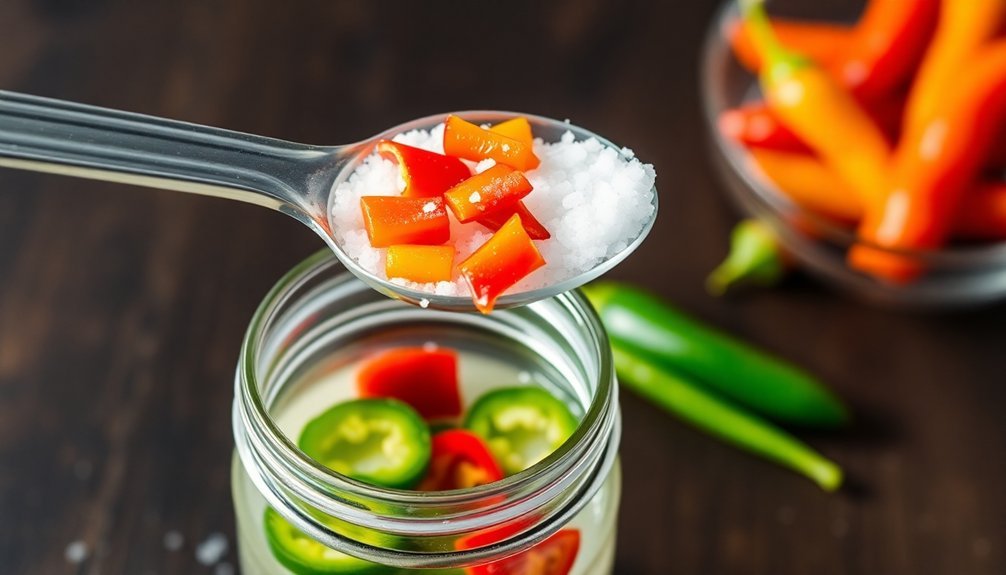



Leave a Reply